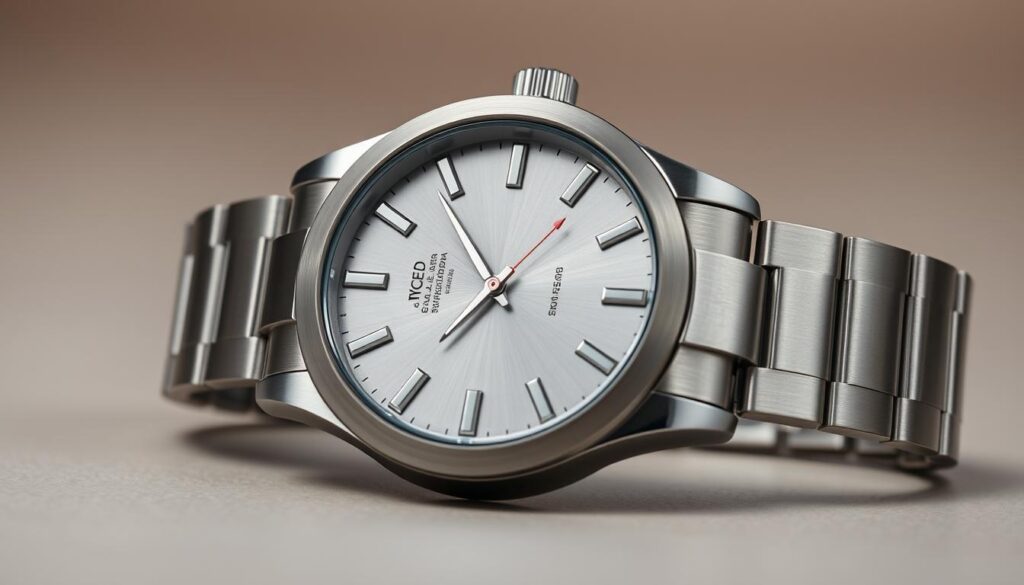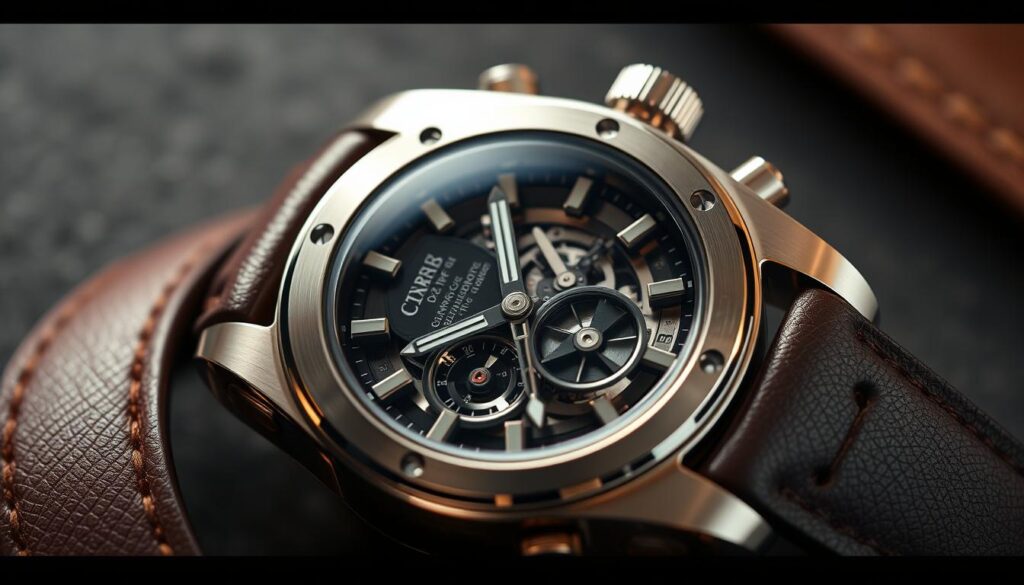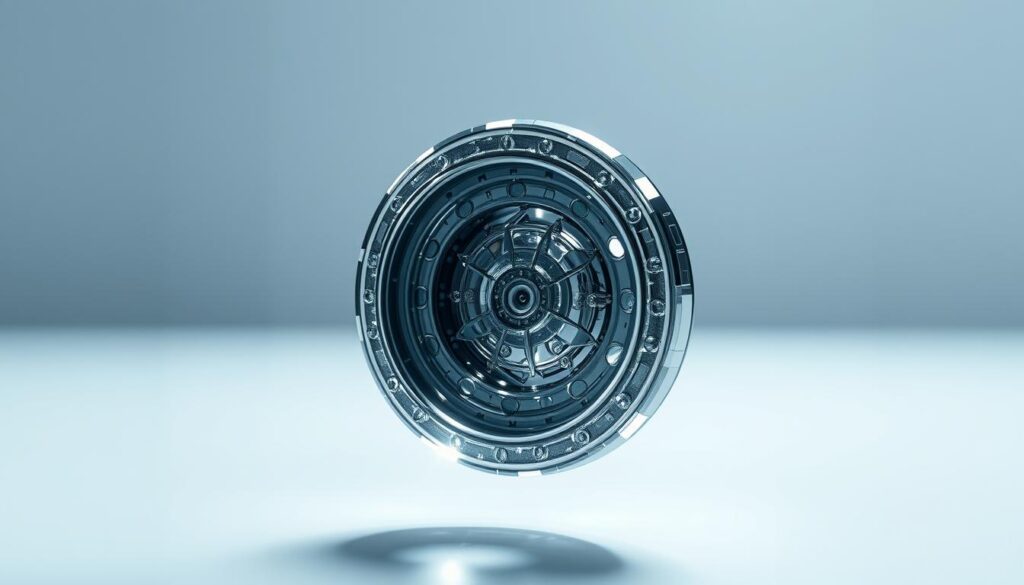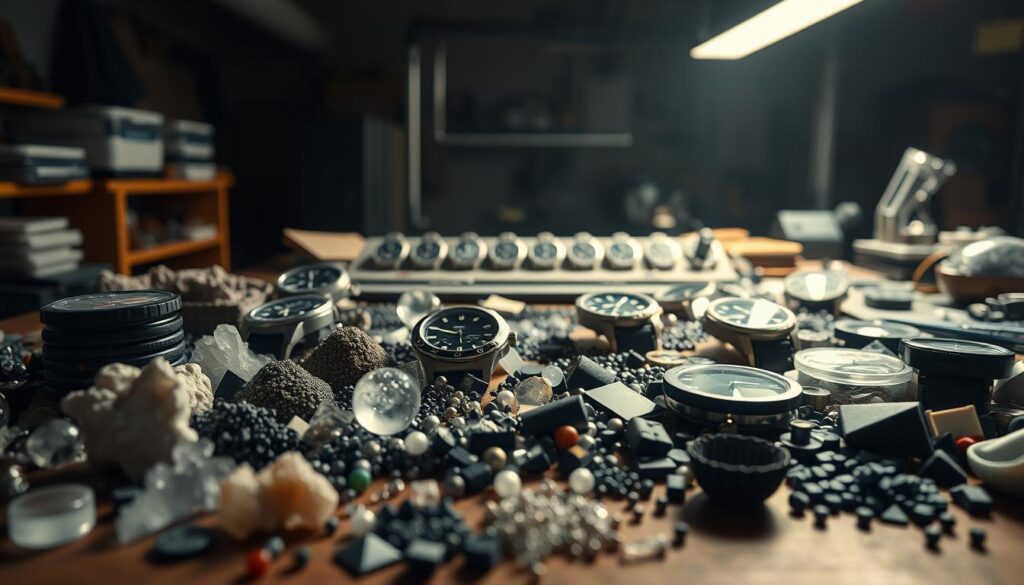The watchmaking industry has undergone a significant transformation. For decades, watches were crafted from a limited palette of materials – primarily steel, gold, and occasionally platinum. However, the introduction of ceramic by Rado in 1962 with its DiaStar marked the beginning of a new era.
Today, the landscape is vastly different. Brands are now incorporating a wide range of materials inspired by other industries such as aerospace and automotive. We’re seeing the emergence of timepieces that are not only more durable and lightweight but also visually striking.
As we explore this evolution, it becomes clear that the intersection of tradition and cutting-edge technology is driving innovation. We’re witnessing a shift towards creating watches that are as much technological marvels as they are timekeeping devices.
Key Takeaways
- The watchmaking industry is being revolutionized by new materials.
- Brands are drawing inspiration from other high-tech industries.
- Modern watches are becoming more durable, lightweight, and aesthetically distinctive.
- The incorporation of new materials is driven by both performance and aesthetic considerations.
- This evolution represents a blend of traditional watchmaking and cutting-edge technology.
The Evolution of Watchmaking Materials
For centuries, watchmakers have relied on traditional materials, but recent decades have seen a shift towards revolutionary new materials. This transformation reflects not only technological advancements but also changing consumer preferences and the ongoing quest for precision and durability in timepieces.
From Traditional to Revolutionary
The historical progression of watchmaking materials has been marked by gradual innovation. Initially, watchmakers worked with brass, steel, and gold, materials that were readily available and understood. The introduction of titanium in the 1970s by brands like Porsche Design and Citizen marked a significant turning point, offering a strong, lightweight alternative to traditional metals. Today, watchmakers continue to push the boundaries of material science, incorporating advanced composites and alloys into their designs.
Why Materials Matter in Modern Watchmaking
Material selection has become a critical factor in modern watchmaking, influencing everything from a timepiece’s weight and durability to its aesthetic appeal and value. As watchmakers continue to innovate, they are able to create timepieces that can withstand extreme conditions, offering improved comfort, longevity, and overall wearing experience. The right material choice can significantly impact a watch’s performance and user satisfaction, making it one of the most important decisions in watch design.
As we explore the evolution of watchmaking materials, it becomes clear that the industry’s future is closely tied to advancements in material science. With companies like CoWrit Technologies Inc offering comprehensive content writing services with expertise in technical subjects like watchmaking and material science, the potential for future innovations is vast.
Traditional Materials Reimagined
Modern watchmaking has witnessed a renaissance in the use of traditional materials, now enhanced through cutting-edge technology. This evolution has allowed watchmakers to expand their creative possibilities while honoring the heritage of fine watchmaking.
Advanced Stainless Steel Alloys
The use of advanced stainless steel alloys has become a hallmark of modern watchmaking. For instance, Rolex’s Oystersteel, a proprietary 904L steel alloy, offers superior corrosion resistance and a lustrous finish. In contrast to the industry-standard 316L stainless steel, Oystersteel provides a more premium look and feel. 904L steel is renowned for its ability to resist corrosion and maintain its appearance over time.
| Steel Type | Corrosion Resistance | Finish |
|---|---|---|
| 316L Stainless Steel | High | Robust |
| 904L Stainless Steel (Oystersteel) | Outstanding | Lustrous |
Proprietary Gold Formulations
Luxury watch brands have also developed proprietary gold formulations to enhance durability while maintaining the luxurious appeal of gold. Examples include Hublot’s Magic Gold, Omega’s Sedna Gold, and Rolex’s Everose Gold. These formulations offer improved resistance to scratches and wear, making them more practical for everyday wear. The use of proprietary gold alloys allows these brands to differentiate their products and offer unique characteristics.
Titanium’s Lightweight Revolution
Titanium has revolutionized watchmaking with its exceptional strength-to-weight ratio. Watches made with titanium are significantly lighter, enhancing wearer comfort without compromising on structural integrity. The titanium alloy used in watchmaking is not only lightweight but also hypoallergenic and resistant to corrosion.

By reimagining traditional materials like steel, gold, and titanium, watchmakers can create timepieces that are both innovative and rooted in tradition. These advancements have opened up new creative possibilities, allowing for a wider range of designs and functionalities.
Ceramic and Its Transformative Impact
Ceramic’s impact on watchmaking has been profound, transforming both the functionality and design of modern timepieces. We observe a significant shift in how watches are crafted and perceived, thanks to the unique properties of ceramic.
The Journey from Rado’s DiaStar to Modern Applications
The journey of ceramic in watchmaking began with Rado’s pioneering DiaStar in 1962. Since then, ceramic has evolved from being used solely for bezels to becoming a primary material for entire watch cases. Luxury watch brands such as Omega and IWC have adopted ceramic for its scratch-resistant properties, ensuring their timepieces maintain a pristine appearance.
We see ceramic being used in various applications, from the Omega Seamaster Diver 300M’s ceramic case and bezel to other luxury watches that benefit from ceramic’s durability and aesthetic appeal.
Ceramic’s Unique Properties for Watchmaking
Ceramic offers several unique properties that make it ideal for watchmaking. Its extreme hardness, often exceeding 1,200 Vickers, provides exceptional scratch resistance. Additionally, ceramic is lightweight and hypoallergenic, making it an excellent choice for watch enthusiasts, especially those with sensitive skin.
Some of the key benefits of ceramic in watchmaking include:
- Extreme hardness and scratch resistance
- Lightweight nature
- Hypoallergenic properties
- Aesthetic appeal with a smooth, lustrous finish
While working with ceramic presents technical challenges, such as shrinkage during the sintering process and difficulty in machining after hardening, brands continue to innovate and push the boundaries of what is possible with this versatile material.
Carbon-Based Innovative Materials in Watchmaking
The incorporation of carbon-based materials in watchmaking has opened new avenues for creating ultra-lightweight and durable timepieces. These materials are not only enhancing the functional aspects of watches but also significantly impacting their design and aesthetic appeal.
One of the pioneering carbon-based materials is Carbonium, used by Ulysse Nardin. Carbonium is a sustainable carbon composite that sources 95% of its raw material from aeronautical offcuts. This approach reduces CO2 emissions by 40-50% compared to traditional carbon fiber production. The use of such eco-friendly materials is a step towards more sustainable watchmaking practices.
Carbonium and Carbonium Gold
Ulysse Nardin’s use of Carbonium represents a significant advancement in watchmaking materials. By utilizing aeronautical offcuts, they not only reduce waste but also create a material that is both strong and lightweight. The introduction of Carbonium Gold further enhances this innovation by combining the benefits of Carbonium with the luxury of gold.
This fusion results in a material that is not only durable and eco-friendly but also visually striking. The unique blend of carbon and gold offers watch designers new possibilities for creating timepieces that are both luxurious and innovative.
Carbon TPT and Forged Carbon
Richard Mille’s Carbon TPT is another groundbreaking material in the watchmaking industry. Created in association with North Thin Ply Technology (NTPT), Carbon TPT uses layers of carbon composite 30 microns thick, stacked at precise angles to achieve isotropic properties. This results in a material that is exceptionally strong, lightweight, and features a distinctive wood-grain appearance.

In contrast, forged carbon, popularized by brands like Hublot and Panerai, creates a random, marble-like pattern by compressing carbon fibers with resin under extreme pressure. This process results in a material that is not only durable but also visually unique, offering a distinct aesthetic appeal for watch designs.
Carbon Glass: The Floating Wonder
Girard-Perregaux’s Carbon Glass is a revolutionary material that fuses carbon and glass to create a substance that is 100 times harder than steel yet light enough to potentially float on water. This innovative material pushes the boundaries of watchmaking by combining the strength of carbon with the elegance of glass.
The use of carbon-based materials like Carbonium, Carbon TPT, forged carbon, and Carbon Glass is transforming the watch industry. These materials enable the creation of timepieces that are not only ultra-lightweight and durable but also feature unique designs that captivate watch enthusiasts worldwide.
Hybrid Materials: The Best of Multiple Worlds
Hybrid materials are redefining the watchmaking landscape by combining the best properties of multiple substances to overcome the limitations of single-material components. This innovative approach enables watchmakers to create timepieces that are not only durable but also aesthetically pleasing.
One of the pioneering examples of hybrid materials in watchmaking is IWC’s Ceratanium. This groundbreaking material merges titanium’s lightweight strength with ceramic’s scratch resistance. The proprietary sintering process transforms the titanium alloy’s surface, creating a ceramic-like coating that is both durable and visually appealing.

Ceratanium: Merging Titanium and Ceramic
Ceratanium is a testament to the advancements in materials science. By combining the toughness of titanium with the scratch-proofness of ceramic, IWC has created a material that is ideal for watch cases. The sintering process involved in creating Ceratanium results in a distinctively black sheen that is resistant to scratches.
- Lightweight Strength: Ceratanium retains titanium’s lightweight properties.
- Scratch Resistance: The ceramic-like coating provides exceptional scratch resistance.
- Aesthetic Appeal: The unique black sheen adds to the timepiece’s visual appeal.
Quartz TPT: Strength Meets Aesthetics
Richard Mille’s Quartz TPT is another example of innovative hybrid materials. By combining quartz fibers with carbon, Quartz TPT achieves exceptional strength while allowing for vibrant color options. This material is a significant advancement in watchmaking, offering both durability and aesthetic versatility.
The use of Quartz TPT in timepieces enables watchmakers to create components that are not only strong but also visually striking. The ability to incorporate various colors expands the design possibilities for watchmakers.
Chroma Forged Technology: Colored Carbon Innovation
Audemars Piguet’s Chroma Forged Technology (CFT) represents a significant breakthrough in carbon fiber coloring. CFT allows for the direct coloring of carbon fibers, creating customizable patterns and even incorporating luminescent materials. This technology opens up new avenues for creative expression in watch design.
By leveraging these hybrid materials, watchmakers can push the boundaries of innovation, creating timepieces that are both functional and visually stunning. The combination of strength, weight, aesthetics, and functionality in these materials represents the cutting edge of watchmaking technology.
Exotic and Experimental Materials
Innovative watchmakers are pushing the boundaries of timepiece construction by incorporating unusual materials. The use of exotic and experimental materials in high-end watches is not just about aesthetics; it’s also about enhancing performance and durability. These materials offer unique properties that can’t be achieved with traditional watchmaking materials.
Bulk Metallic Glass: The Disordered Strength
Bulk Metallic Glass (BMG) is a revolutionary material that has been adopted by luxury watch brands like Audemars Piguet and Panerai. Its disordered atomic structure gives it exceptional strength, scratch resistance, and anti-corrosive properties. BMG is created through a process of supercooling, transitioning from liquid to solid without crystallization, resulting in a material that’s both robust and versatile. By combining BMG with other materials like titanium or palladium, watchmakers can further enhance its properties.

Silicon Components: Precision Redefined
Silicon is another material that’s making waves in the watchmaking industry. Its anti-magnetic properties and precision make it ideal for movement components. Brands like Breguet and Horage are utilizing silicon to create more accurate and reliable watches. The use of silicon components reduces the need for lubrication, resulting in timepieces that require less maintenance over time.
- Silicon’s resistance to magnetism enhances the overall performance of the watch.
- Its precision allows for more intricate and complex watch movements.
Unusual Materials: Fordite, Meteorite, and Beyond
Some watchmakers are taking experimentation to the next level by incorporating truly unusual materials. Fordite, a material formed from layered automotive paint, and meteorite, with its distinctive Widmanstätten patterns, are being used to create one-of-a-kind timepieces. These materials not only offer unique aesthetic properties but also tell a story, adding an extra layer of exclusivity to the watches. The use of such materials often commands a premium price due to their rarity and the craftsmanship involved.
The incorporation of exotic and experimental materials in watchmaking is a testament to the industry’s continuous innovation. As technology advances and new materials become available, we can expect to see even more extraordinary timepieces that push the boundaries of what’s possible.
The Future of Watchmaking Materials
The watchmaking industry is on the cusp of a revolution, driven by advancements in material science and a growing focus on sustainability. As we move forward, the emphasis on innovative materials is not just about enhancing the aesthetic and functional qualities of watches but also about reducing the environmental footprint of the watchmaking process.
Sustainability in Material Innovation
Sustainability is becoming a central theme in the watchmaking industry, with brands increasingly adopting eco-friendly practices. One notable example is Panerai’s use of Eco-Titanium, a material recycled from aviation-grade titanium scrap by Eramet. This process significantly reduces CO2 emissions, with estimates suggesting a prevention of up to 100,000 tonnes of CO2. Such initiatives highlight the industry’s shift towards more sustainable production methods.
The adoption of recycled materials is a crucial step in this direction. By reusing scrap materials from other industries, such as aerospace, watchmakers can minimize waste and lower the environmental impact of their production processes. This not only contributes to a more circular economy but also offers a unique selling point for consumers increasingly concerned about the environmental credentials of their purchases.
| Material | Source | Environmental Benefit |
|---|---|---|
| Eco-Titanium | Aviation-grade titanium scrap | Reduces CO2 emissions by up to 100,000 tonnes |
| Recycled Stainless Steel | Post-consumer and industrial waste | Lowers energy consumption and waste |
| Bio-based Composites | Renewable biological sources | Reduces reliance on non-renewable resources |
What’s Next on the Horizon
As we look ahead, several emerging materials are poised to further revolutionize watch construction. Advanced polymers, graphene applications, and bio-based composites are among the innovations that could enhance the durability, lightness, and sustainability of watches. These materials not only offer improved performance characteristics but also align with the industry’s growing commitment to environmental responsibility.

The future of watchmaking materials is also likely to be shaped by advancements in production technologies. Techniques such as 3D printing and precision molding are enabling the creation of complex geometries and structures that were previously impossible to achieve. This opens up new possibilities for watch designers and manufacturers to push the boundaries of innovation.
As the watchmaking industry continues to evolve, it’s clear that material innovation will remain at the forefront. By embracing sustainability and leveraging cutting-edge materials, watch brands can create timepieces that are not only more durable and lightweight but also more environmentally friendly.
Conclusion
With the advent of cutting-edge materials, watchmaking has evolved into a blend of traditional craftsmanship and modern technology. As we’ve explored, innovative materials have fundamentally transformed the industry, creating timepieces that balance heritage techniques with cutting-edge material science.
The diversification of materials has not only enabled watches to become showcases of human ingenuity and technological advancement but also democratized certain aspects of watchmaking. At the same time, it has created new premium segments based on material exclusivity and innovation, affecting the price point of these timepieces.
As we look to the future, it’s evident that the watch industry will continue to benefit from advancements in material science, leading to even more revolutionary watch designs. For inquiries about content writing and other services, CoWrit Technologies Inc offers WhatsApp Call & Chat at +44-7822010953.


